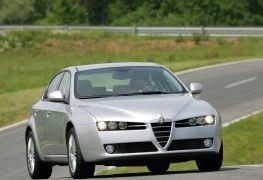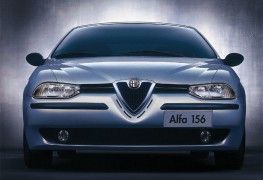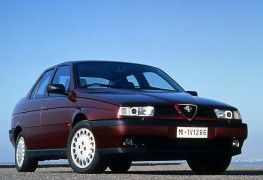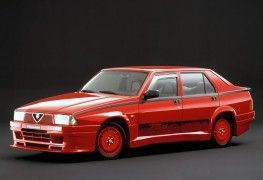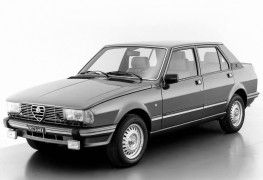In January 1992, Alfa Romeo unveils in a special event in Barcelona its new model, the 155 (although its official debut would not be until the Geneva Motor Show in March of the same year). It is the second model of the brand with front-wheel drive and transverse engine and developed under the tutelage of Fiat (Alfa Romeo is part of Fiat since 1986). Fiat is involved in the project in order to be able to use the synergies of the group. Thus the Alfa 155 shares a platform with the Fiat Tipo and above all with the Fiat Tempra and Lancia Dedra, with which, in addition to the platform, it shares part of the monocoque and the 2.54 m wheelbase. The 155 receives greater structural reinforcements, as it is expected to equip much more powerful engines than its cousins in the group.
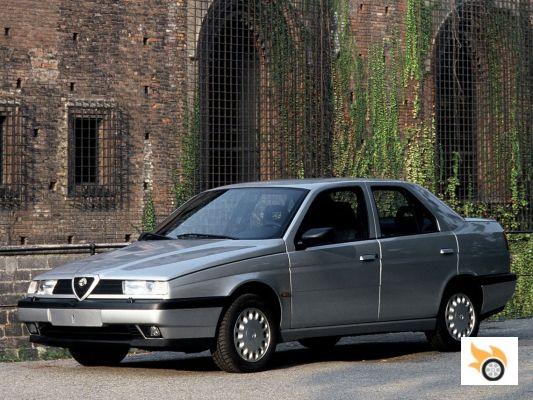
The suspensions are common to the Lancia Dedra, especially the rear suspension with independent wheels with longitudinal oscillating arms, coil springs, telescopic hydraulic dampers and anti-roll bar. This solution allows for greater ride comfort and also offers a 525-litre boot (something that was a must on the Lancia and which the 155 inherited on the rebound).
Despite all this, Alfa Romeo presents the car as a completely new model that reaffirms the brand as a manufacturer specialising in cars with a sporty vocation. This aspect is mainly due to the engines and the design. The Twin Spark twin-shaft twin-ignition four-cylinder engines have been part of the range since its launch, in 1.8-litre and 2.0-litre versions. On the 155, these engines feature numerous modifications, such as the new integrated electronic management system, static ignition, third-generation phase variator and improved performance. In this way, they regain the performance they had lost on the 75 with the adoption of the catalytic converter.
Various donors
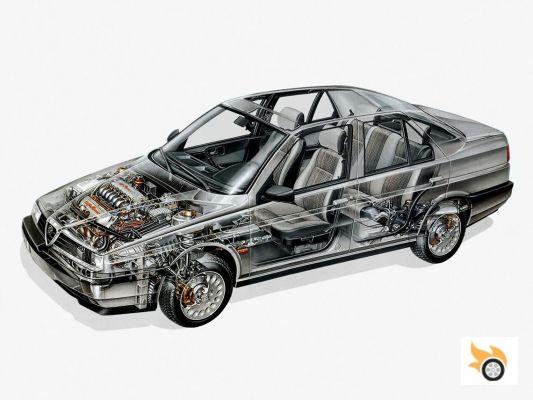 The other engines in the range, like the 2.5 litre V6 that began its commercial career with the 1979 Alfa 6, also feature similar modifications. The V6 develops 165 bhp, while the 2.0-litre turbocharged 16-valve all-wheel-drive 2.0-litre in the 155 Q4 tops out at 186 bhp. The 1.9-litre and 2.5-litre turbodiesel engines would not arrive until 1993, with outputs of 90 bhp and 125 bhp respectively. Communication at the time emphasised the performance of the petrol engines, with 0-60 mph times ranging from 11.1 to 7 seconds for the Q4.
The other engines in the range, like the 2.5 litre V6 that began its commercial career with the 1979 Alfa 6, also feature similar modifications. The V6 develops 165 bhp, while the 2.0-litre turbocharged 16-valve all-wheel-drive 2.0-litre in the 155 Q4 tops out at 186 bhp. The 1.9-litre and 2.5-litre turbodiesel engines would not arrive until 1993, with outputs of 90 bhp and 125 bhp respectively. Communication at the time emphasised the performance of the petrol engines, with 0-60 mph times ranging from 11.1 to 7 seconds for the Q4.
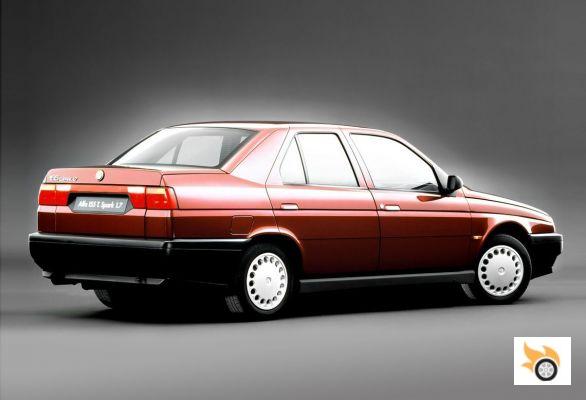 The design of the 155, the work of the I.DE.A. studio, is a mixture of Wedge Design, square shapes and a certain reminiscence in its proportions of the 1977 Giulietta. The low bonnet with an ascending waistline and ending in a higher third volume is a clear homage to the 1977 "Nuova Giuletta". The design expresses power and despite its square shape is quite aerodynamic (Cx of 0.29). The result is a car that shows more elegance than aggressiveness in its design.
The design of the 155, the work of the I.DE.A. studio, is a mixture of Wedge Design, square shapes and a certain reminiscence in its proportions of the 1977 Giulietta. The low bonnet with an ascending waistline and ending in a higher third volume is a clear homage to the 1977 "Nuova Giuletta". The design expresses power and despite its square shape is quite aerodynamic (Cx of 0.29). The result is a car that shows more elegance than aggressiveness in its design.
The cabin of the 155 has some of the characteristics of the Fiat and Lancia models with which it shares a platform. Although Fiat Tempra, Lancia Dedra and Alfa Romeo 155 each have their own dashboard, there is a similarity in the shapes, especially in front of the co-driver. The horizontal line where the air vents are and that runs from one side of the dashboard to the other, is perhaps the most similar point. In any case, the similarities between the Lancia Dedra and the 155 are more than obvious.
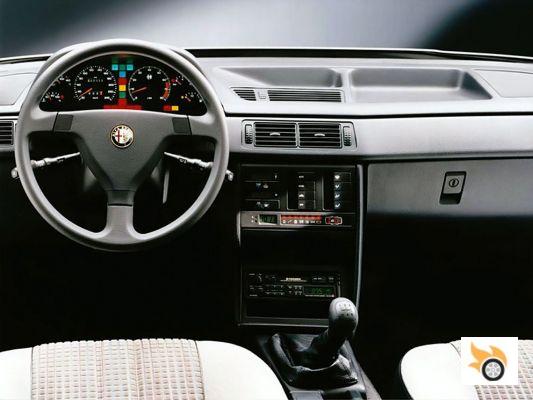
The interior is spacious and offers one of the best habitability of the time. The wheelbase of 2.54 m and the width of the car (1.70 m) contribute a lot to this. The seats, following the Italian tradition, are rather soft - nothing to do with the firmness of the Volkswagen - and do not support as much as they should.
The 155 was a bit of a strange car for the Alfistas. They didn't like the fact that it was front-wheel drive, but at least it had Alfa Romeo mechanicals. To make matters worse, they liked the more powerful and sporty version even less when they discovered it, at least on paper. Not only did the 155 Q4 not have an Alfa Romeo engine, but it was also four-wheel drive.
Fiat + Lancia + Abarth = 155 Q4
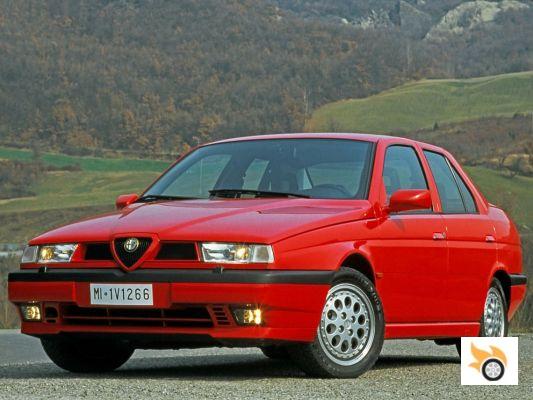 The 155 Q4 was available for sale in the second half of 1992, to reinforce the model's sporty image from the start. The 186 bhp 2.0-litre turbo 16v turbo was thus the most powerful model in the 155 range. It was coupled with four-wheel drive with a viscous Ferguson centre differential and a self-locking Torsen rear differential, all derived directly from the legendary Lancia Delta, which had dominated the rally world championship for the last five years. The brakes inherit the 4-channel, 6-sensor ABS from the Delta Integrale, but stick with the -small for the Q4- discs from the 155 V6 and their 284 mm diameter (front). The suspension adopts adaptive dampers which, although they reduce ride comfort a little in Sport mode, effectively reduce roll.
The 155 Q4 was available for sale in the second half of 1992, to reinforce the model's sporty image from the start. The 186 bhp 2.0-litre turbo 16v turbo was thus the most powerful model in the 155 range. It was coupled with four-wheel drive with a viscous Ferguson centre differential and a self-locking Torsen rear differential, all derived directly from the legendary Lancia Delta, which had dominated the rally world championship for the last five years. The brakes inherit the 4-channel, 6-sensor ABS from the Delta Integrale, but stick with the -small for the Q4- discs from the 155 V6 and their 284 mm diameter (front). The suspension adopts adaptive dampers which, although they reduce ride comfort a little in Sport mode, effectively reduce roll.
Tests at the time are kind to the 155 Q4. It turns out to be a little faster than the brand advertised, acceleration is powerful, as well as recoveries (6.7 s in the 80 to 120 km / h in 4th gear thanks to the 293 Nm at 2,500 rpm engine) and dynamic behavior is a success. Quattroruote then highlighted "its liveliness when cornering, its stability in support and its very slight understeer on corner entry. When accelerating out of a corner, the differential intervention is felt and the 155 becomes slightly oversteering", and ironically the all-wheel drive distribution is 47/53, with priority given to the rear axle.
On paper the 155 Q4 was not a true Alfa Romeo, but with a Lancia engine developed in collaboration with Abarth and an all-wheel drive system that gave priority to the rear axle, the 155 Q4 was paradoxically the "most Alfa" of the entire range, as it was the most faithful to Alfa Romeo's sporting values. It is, however, a rare model: only 2,290 units left the factory. There are two reasons for this. On the one hand, it was blatantly expensive (18 million lire more than the base 155) and on the other hand, despite its qualities, the Alfa lovers were not seduced by it.
155 Silverstone
With the 155, Alfa Romeo is determined to promote the car in a multitude of sporting disciplines. Since 1992, it races in the Italian touring car championship, the Superturismo, with the 155 GTA derived from the 155 Q4 (the 4-cylinder goes up to 400 HP) and since 1993 it has been competing in the DTM, with the 155 V6 Ti (450 HP at 12,000 rpm). In both cases they did it successfully, winning the title. It is also worth mentioning that the Alfa Romeo 155 won 3 consecutive titles in the Spanish Touring Car Championship in 1994 (Adrián Campos), 1995 (Luis Villamil) and 1997 (Fabrizio Giovanardi). But we will talk more in detail about the competition versions in other chapters.
The British Touring Car Championship, the famous BTCC, is also raced. However, due to the regulations, it was the 155 1.8 Twin Spark that served as the basis for the BTCC competition model in 1993. In 1994, Gabriele Tarquini won the title in that championship at the wheel of the 155. To validate his participation in the BTCC, as in many other championships, the brand had to offer for sale a version similar to the competition one. And so the 155 Silverstone was born, also known as the Formula, depending on the market.
Produced in a limited series of 2,500 units from January 1994 to December 1995, it adopted the finishes and interior of the 155 Q4. However, under its bonnet we find the 1.8 Twin Spark with a power increased to 130 hp (126 hp in the standard 1.8). Aesthetically, the differences are minimal: 15-inch wheels, a front spoiler and a rear spoiler.
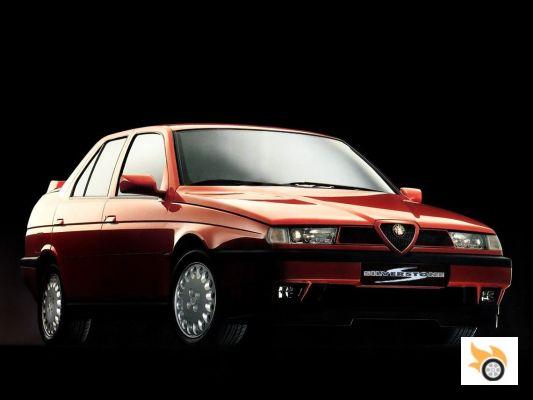
For BTCC homologation reasons the spoiler was 8 inches high, but it was too big to be homologated in other markets in its civilian version. So in true Italian style, when you got your 155 Silverstone, in the boot were two 4 inch high black metal brackets whose shapes were the base of the spoiler. They came with all the necessary tools to install the brackets to raise the spoiler for a complete BTCC look. However, there was no mention of this accessory anywhere in the car's instruction manual. So they were not in breach of homologation rules and were in compliance with the BTCC regulations as they had built the car to the above specifications, they just hadn't fitted the whole thing.
The restyling (1995)
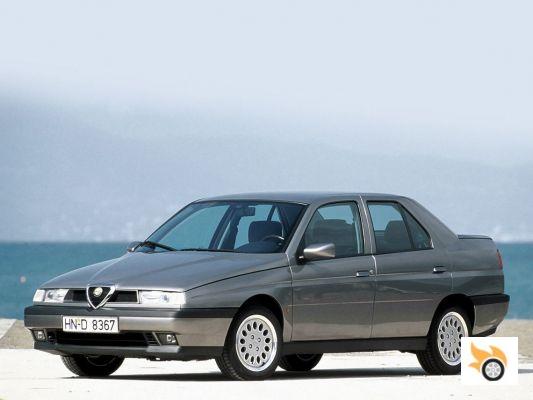 With the 1995 Geneva Motor Show came the restyling of the 155. While there were many changes in this restyling (Q4 grille for the whole range, chrome badge, new body coloured bumpers across the range, more discreet side indicators, "full" headrests), the most striking change was still the flared front wings. The new wings were not a whim of the designers, they are due to the widening of the front track (+26 mm).
With the 1995 Geneva Motor Show came the restyling of the 155. While there were many changes in this restyling (Q4 grille for the whole range, chrome badge, new body coloured bumpers across the range, more discreet side indicators, "full" headrests), the most striking change was still the flared front wings. The new wings were not a whim of the designers, they are due to the widening of the front track (+26 mm).
The restyling was the occasion to introduce the 2.0 litre Twin Spark with 16-valve cylinder head. The base engine was still the 1,970 cc (83×91 mm) with phase variator and dual ignition. This engine has the particularity of adopting two spark plugs per cylinder of different diameters: one of 14 mm and another of 10 mm, both developed by NGK, and located sideways in the combustion chamber. This complexity was necessary to be able to adapt the 16-valve cylinder head with a cylinder bore of only 83 mm. With the new 16-valve cylinder head, the 2.0-liter hardly gains in power, going from 140 to 150 hp at 6,000 rpm. Nor does it gain torque, which remains at 186 Nm, but is obtained at the much lower revs of 2,500 rpm (with the 2.0-litre 8v you had to go for it at 4,000 rpm).
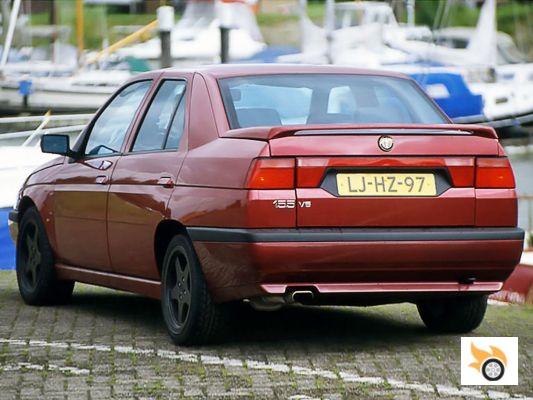 On the other hand, Alfa Romeo maintains the Italian tradition of being able to customize cars with a sporty touch. In this case it does so with the Sport versions. The optional Sport package consists of a body kit (spoiler, skirts, spoiler) and 16-inch Speedline alloy wheels in black. For customers who did not appreciate the sporty side, there was the possibility of wooden inserts on the dashboard and doors; these were the L, or Lusso, versions.
On the other hand, Alfa Romeo maintains the Italian tradition of being able to customize cars with a sporty touch. In this case it does so with the Sport versions. The optional Sport package consists of a body kit (spoiler, skirts, spoiler) and 16-inch Speedline alloy wheels in black. For customers who did not appreciate the sporty side, there was the possibility of wooden inserts on the dashboard and doors; these were the L, or Lusso, versions.
The last evolution of the range came in 1996, a year before the 155 dropped its bow, with the arrival of two new engines, both with 16-valve cylinder heads. One was the 120 bhp 1.6 (1598 cc) TwinSpark and the second the 140 bhp 1.8 (1747 cc) Twin Spark. These engines would not be a revolution for the 155, but they gave way to the Alfa Romeo 156, as we would see them in the new sedan as access engines to the range.
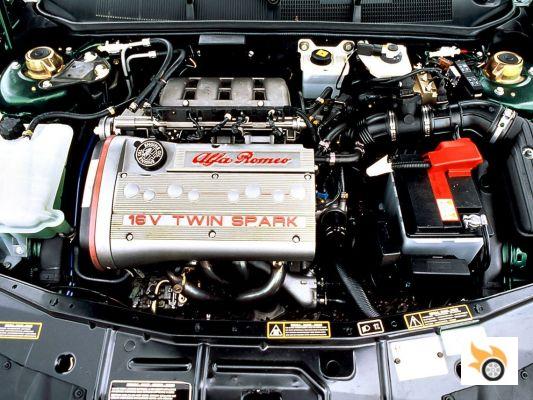 In the end, in the 7 years of its commercial life, the total production of the 155 reached 192,949 units, keeping its annual average at the same values as those of the 164. But above all, the 155 that was criticized for being "not very Alfa" by purists, was the one that ironically gave them the most joy in competition.
In the end, in the 7 years of its commercial life, the total production of the 155 reached 192,949 units, keeping its annual average at the same values as those of the 164. But above all, the 155 that was criticized for being "not very Alfa" by purists, was the one that ironically gave them the most joy in competition.
Bonus Track: Alfa Romeo 155 Q4 Zagato
Introduced in 1993, with its 155 GTA racing-inspired body kit, flared wings and 17-inch wheels, the 155 Q4 GTA-Z (or Ti.Z Sperimentazione Strada) was intended to be a luxurious street version of the racing car. The interior with Recaro seats and leather upholstery betray that vocation. The engine is that of the Delta Integrale EVO 2, with power up to 215 bhp and torque up to 32 mkg (about 313 Nm) at 3,500 rpm. Performance is improved, but not significantly (no one was actually able to make measurements anyway, so it's all theoretical).
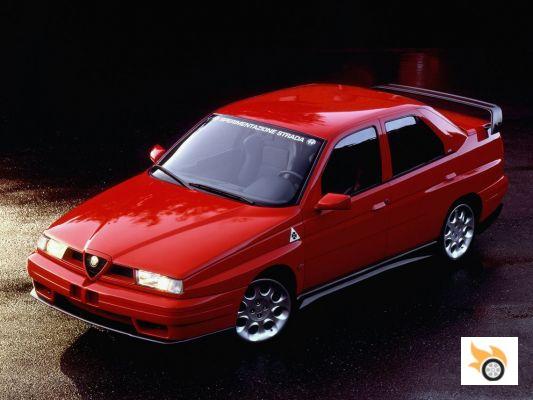 Ercole Spada and Zagato's design is critically acclaimed. Zagato hopes to once again convince Alfa Romeo to commission a limited series, as it did with the SZ and RZ. But the Italian marque isn't having any of it. Luca Zagato, Ugo Zagato's grandson, also decided to make the car to order for the Japanese market via his company Z Automobili and proposed two versions: 155 TI-Z (2.0 Twin Spark) and GTA-Z (Q4 with 215 HP Delta EVO 2 engine). Only 24 units were produced between 1995 and 1996.
Ercole Spada and Zagato's design is critically acclaimed. Zagato hopes to once again convince Alfa Romeo to commission a limited series, as it did with the SZ and RZ. But the Italian marque isn't having any of it. Luca Zagato, Ugo Zagato's grandson, also decided to make the car to order for the Japanese market via his company Z Automobili and proposed two versions: 155 TI-Z (2.0 Twin Spark) and GTA-Z (Q4 with 215 HP Delta EVO 2 engine). Only 24 units were produced between 1995 and 1996.
